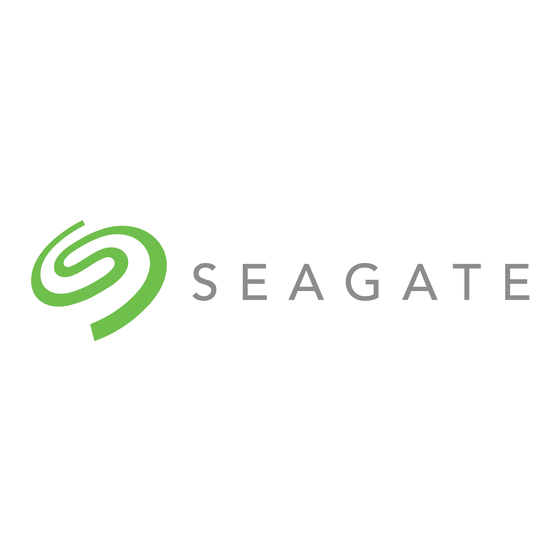Summarization of Contents
2.0 Drive Specifications
2.1 Specification Summary
Offers a quick reference table outlining the key specifications of the drives.
2.2 Formatted Capacity
Lists the formatted capacity, guaranteed sectors, and bytes per sector for each model.
2.3 Default Logical Geometry
Describes the default logical geometry, including cylinders, heads, and sectors per track.
2.4 Physical Organization
Outlines the physical organization of the drives, such as read/write heads and number of discs.
2.5 Recording and Interface Technology
Details the recording methods, densities, spindle speed, and ATA interface specifications.
2.6 Physical Characteristics
Specifies the physical dimensions (height, width, length) and typical weight of the drives.
2.7 Seek Time
Provides measurements for track-to-track, average, and full-stroke seek times.
2.8 Time to Ready
Specifies the time required for the drive to become ready after power-on or standby.
2.9 Power Specifications
Details the power requirements and consumption of the drives in various operating modes.
2.9.1 Power Consumption
Breaks down power consumption for spinup, idle, seek, read/write, standby, and sleep modes.
2.9.2 Conducted Noise
Specifies the limits for input noise ripple on the +5 volt line.
2.9.3 Voltage Tolerance
Defines the acceptable voltage tolerance range for the drive.
2.9.4 Power-Management Modes
Explains the different power management modes available for energy efficiency.
2.10 Environmental Specifications
Covers environmental operating conditions such as temperature, humidity, and altitude.
2.10.1 Ambient Temperature
Specifies operating and non-operating ambient temperature ranges for the drive.
2.10.2 Temperature Gradient
Details the maximum allowable temperature gradients per hour.
2.10.3 Humidity
Specifies relative humidity and wet bulb temperature limits for operation and storage.
2.10.4 Altitude
Lists operating and non-operating altitude ranges.
2.10.5 Shock
Describes the shock resistance levels for operating and non-operating conditions.
2.10.6 Vibration
Details the vibration resistance levels for operating and non-operating conditions.
2.11 Acoustics
Measures the drive's sound power levels in different acoustic modes.
2.12 Electromagnetic Immunity
Lists electromagnetic immunity tests and their corresponding performance levels and standards.
2.13 Reliability
Covers reliability metrics like MTBF, error rates, load/unload cycles, service life, and warranty.
2.14 Agency Certification
Lists safety and electromagnetic compatibility certifications obtained by the drives.
2.14.1 Safety Certification
Details the safety standards and recognition for the drives.
2.14.2 Electromagnetic Compatibility
Explains EMC directives and compliance requirements for CE marking.
Korean RRL
Provides compliance information specific to Korean regulations.
Australian C-Tick (N176)
Outlines compliance with Australian and New Zealand standards.
2.14.3 FCC Verification
Covers FCC compliance, verification, and radio/television interference guidelines.
3.0 Configuring and Mounting the Drive
3.1 Handling and Static Discharge Precautions
Details essential safety measures for handling the drive to prevent ESD damage.
3.2 Jumper Settings
Explains the jumper block and its configuration options for drive operation.
3.2.1 Master/Slave Configuration
Describes how to set up the drive as master or slave using jumpers.
3.2.2 Cable-Select Option
Explains how to use the cable-select option for master/slave determination.
3.3 Drive Mounting
Provides guidelines and precautions for securely mounting the drive in a system.
4.0 ATA Interface
4.1 ATA Interface Signals and Connector Pins
Lists the signals and pin assignments for the 44-pin ATA interface connector.
4.1.1 Supported ATA Commands
Lists the ATA-standard commands that the drive supports.
4.1.2 Identify Device Command
Details the Identify Device command and the information it transfers about the drive.
4.1.3 Set Features Command
Explains how the Set Features command controls drive features.
4.1.4 S.M.A.R.T. Commands
Describes S.M.A.R.T. commands for failure prediction and drive monitoring.
5.0 Compatibility Summary
5.1 Installation Considerations
Offers advice on replacing hard drives in mobile computers and seeking professional help.
System Compatibility
Lists tested systems, BIOS versions, and operating systems for compatibility assurance.
5.2 BIOS Versions Tested
Lists the BIOS manufacturers and versions tested for compatibility.
5.3 Operating System Versions Tested
Lists the operating systems and their versions tested for compatibility.
5.4 Compatibility Test Configurations
Details the configurations used to test ATA/ATAPI-6 compliance.
5.5 Software Utilities
Lists Seagate and third-party software utilities used during compatibility testing.
5.6 Other Certification
Mentions Microsoft software compatibility.
6.0 Seagate Technology Support Services
Internet
Provides the website for general Seagate product and service information.
Presales Support
Offers contact information for pre-sales inquiries regarding products.
Technical Support
Provides contact details for obtaining technical assistance with the drives.
Warranty Support
Directs users to resources for warranty service and claims.
Customer Service Operations
Details warranty service, data recovery, and authorized service center information.
USA/Canada/Latin America Support Services
Lists contact numbers for support in the Americas region.
Global Customer Support
Provides general contact information for global customer support centers.




Need help?
Do you have a question about the ST94011A - Momentus 40 GB Hard Drive and is the answer not in the manual?
Questions and answers